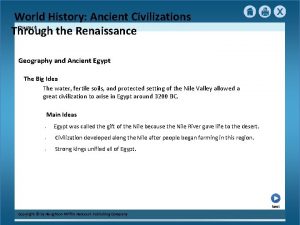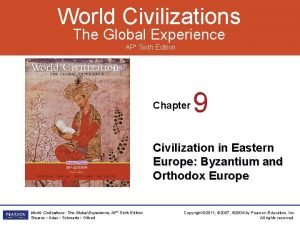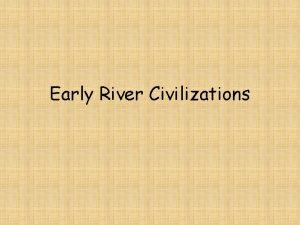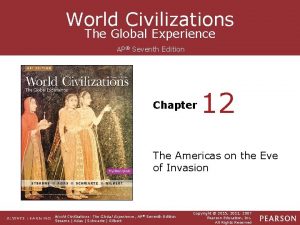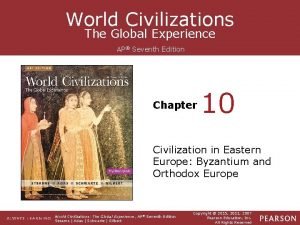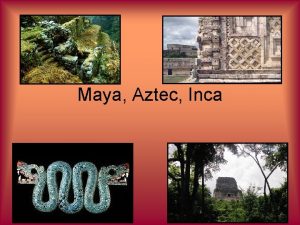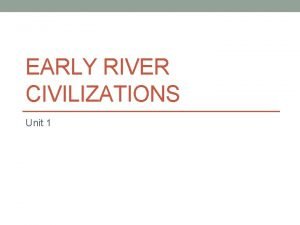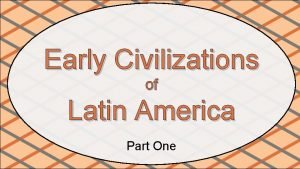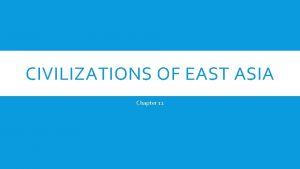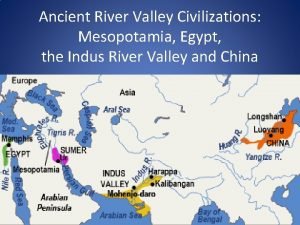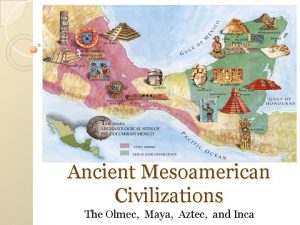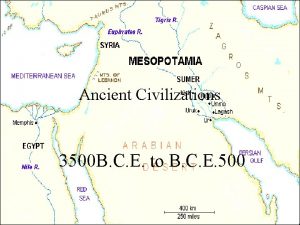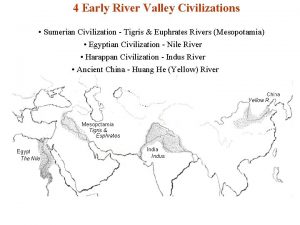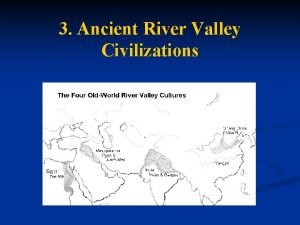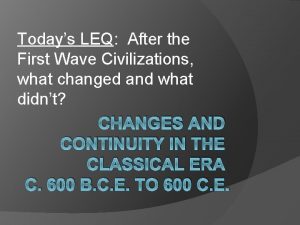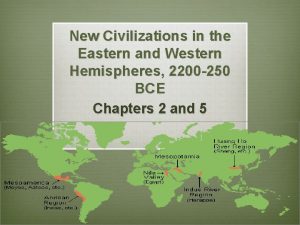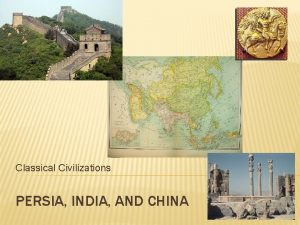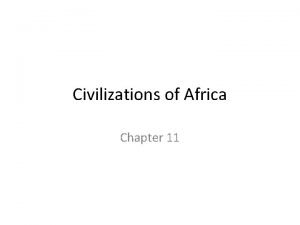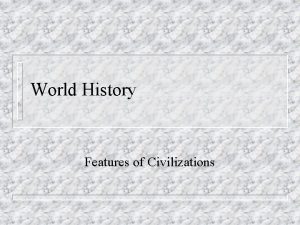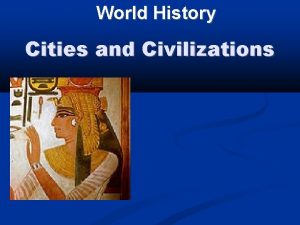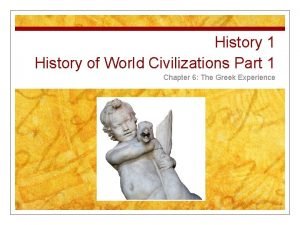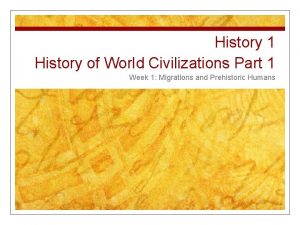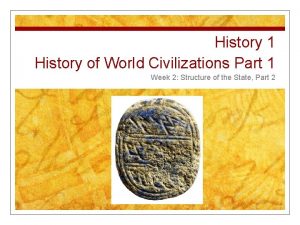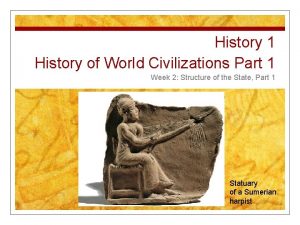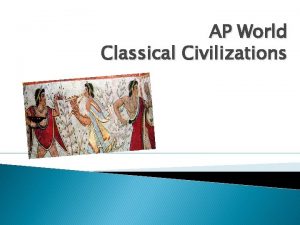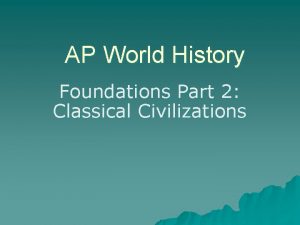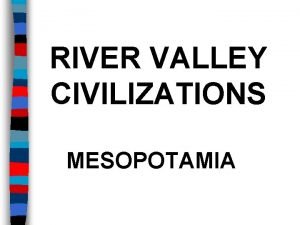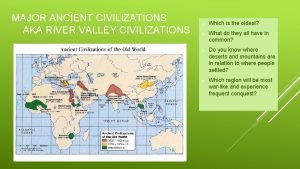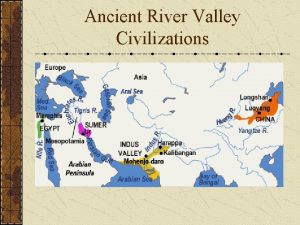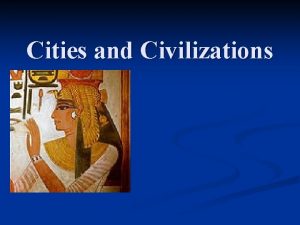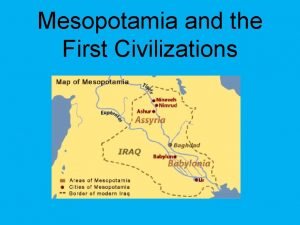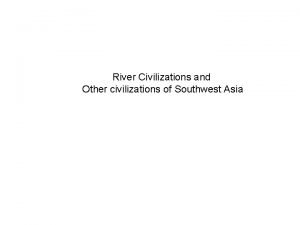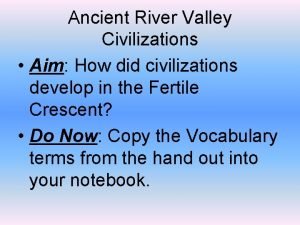History 1 History of World Civilizations Part 1
























- Slides: 24

History 1 History of World Civilizations Part 1 Session 4: Foundations of Indian Society

Recap n Last time we continued our examination of the creation of the state as a method to bring organization some of the earliest human civilizations. n Today we will turn our attention to early civilizations in the Indus River Valley, examining the societies of the Aryans as well as the creation of three major religions– Buddhism, Jainism and Hinduism.

Big Questions of the Day n In what ways did ancient India follow patterns of development similar to those seen elsewhere? n What are the similarities and differences between the religious ideas and practices of early India and those that emerged in the Nile River Valley and southwest Asia?

Defining “India” Term: The Indian Subcontinent

River Valleys of India n Geography: n Indus River Valley n Ganges River Valley

n Harappan India (Neolithic India), 3000 BCE-1500 BCE




The Aryans and the Vedic Age n ca. 1500 -500 BCE n Unsure precisely where Aryans came from. n Speakers of an Indo-European language called Sanskrit n “Aryan” means ‘noble’ and ‘pure’ n Named for the Vedas – ancient sacred works written in Sanskrit

Military Takeover or Cultural Transmission? n Military chief (raja) on top n High priest is second n Warrior class (advise the chief) n Common tribesmen n Conquered non-Aryans (menial workers) n Persian armies record existence of 16 Aryan kingdoms when they arrived in 513 BCE Bronze Aryan sword

The Caste System n The four strata (varna) 1. Brahmins (priests) 2. Kshatriya (warriors) 3. Vaishya (merchants) 4. Shudra (peasants and laborers) Also: outcastes/untouchables The Rig Veda attributed the caste system to the gods.

Was Aryan Society Pyramid-Shaped? Top: Ruler (The King, Pharaoh, etc…) ßSecond tier: religious leaders, scribes, bureaucrats, etc. Below: everyone else, Often divided by class or caste. In a pyramid-shaped society, sovereignty rests at the top. Often captives and slaves at the very bottom.

Religious Ideas of Brahminism n dominance of the Brahmins n The Upanishads n samsara n “reincarnation/transmigration of the soul” n karma n brahman (the unchanging, ultimate reality)

Jainism n Founded by Vardhamana Mahavira (520 BCE? ) Image of a Jain ascetic

Buddhism n Siddhartha Gautama n The Buddha n The Enlightened One

Buddhism Giant Buddha at Bodh Gaya, site where Siddartha found Enlightenment. n Four Noble Truths and the Eightfold Path n “An acknowledgement that the deepest human longings can never be satisfied, and even those things that seem to give pleasure cause anxiety because [people] are afraid of losing them. Attachment to people and things causes sorrow at their loss. ”- Mc. Kay 71. n Term: Nirvana

Subverting the State Religion? n Circumambulating the Stupa – n The Buddha reminded his disciples that each person must reach ultimate fulfillment by individual effort, but recognized the value of striving together for the same goal.

Hinduism n Named for the Indus River n An evolution of Brahmanism n Reaffirmed value of the Vedas n dharma: moral law n Central text: Bhagavad Gita n How does the vertical layering of this frieze differ from the picture of the Buddha earlier?

Comparison Gandharan Buddha Vishnu in Uttar Pradesh

The Persian and Greek Interludes (513 BCE – 183 BCE)

The Mauryan Unification n Chandragupta Maura n Unified Northern India from the Ganges River valley. n Established a complex bureaucracy n Financed public service through taxes on agriculture n Built a regular army What is this an example of?

Reign of Ashoka, ca 269 -232 BCE n Grandson of Chandragupta n Ashoka embraced Buddhism and promoted it beyond India n Ashoka’s monuments are the earliest preserved examples of Indian writing in their original form (translated in 1837) n Mauryan Empire’s decline was followed by another period of decentralization. Buddhist Temple at Sanchi

Next Up: n “China’s Classical Age” n Next time we will examine the early history of China, from its early Neolithic settlements through the Shang and Zhou dynasties, and into the Warring States Period.
 World history ancient civilizations through the renaissance
World history ancient civilizations through the renaissance World civilizations the global experience ap edition
World civilizations the global experience ap edition World civilizations the global experience 7th edition
World civilizations the global experience 7th edition Ancient civilizations of the old world map
Ancient civilizations of the old world map World civilizations the global experience 7th edition
World civilizations the global experience 7th edition World civilizations the global experience 7th edition
World civilizations the global experience 7th edition Ap world history chapter 25 africa and the atlantic world
Ap world history chapter 25 africa and the atlantic world Dangerous world tour setlist
Dangerous world tour setlist Aztecs incas and mayans map
Aztecs incas and mayans map River valley civilizations map
River valley civilizations map 4 river valley civilizations
4 river valley civilizations Inca diorama
Inca diorama Chapter 9 lesson 1 early civilizations
Chapter 9 lesson 1 early civilizations Chapter 11 civilizations of east asia
Chapter 11 civilizations of east asia 4 river valley civilizations
4 river valley civilizations Olmec hearth
Olmec hearth 3500 bc civilizations
3500 bc civilizations River valley civilizations map
River valley civilizations map 4 river valley civilizations
4 river valley civilizations Second wave civilizations
Second wave civilizations Mediterranean civilizations location hemisphere
Mediterranean civilizations location hemisphere Which civilizations were the first to record measurements?
Which civilizations were the first to record measurements? The two classical civilizations of ancient india were the
The two classical civilizations of ancient india were the Chapter 11 section 1 early civilizations of africa
Chapter 11 section 1 early civilizations of africa Chapter 14 pre columbian america answers
Chapter 14 pre columbian america answers
